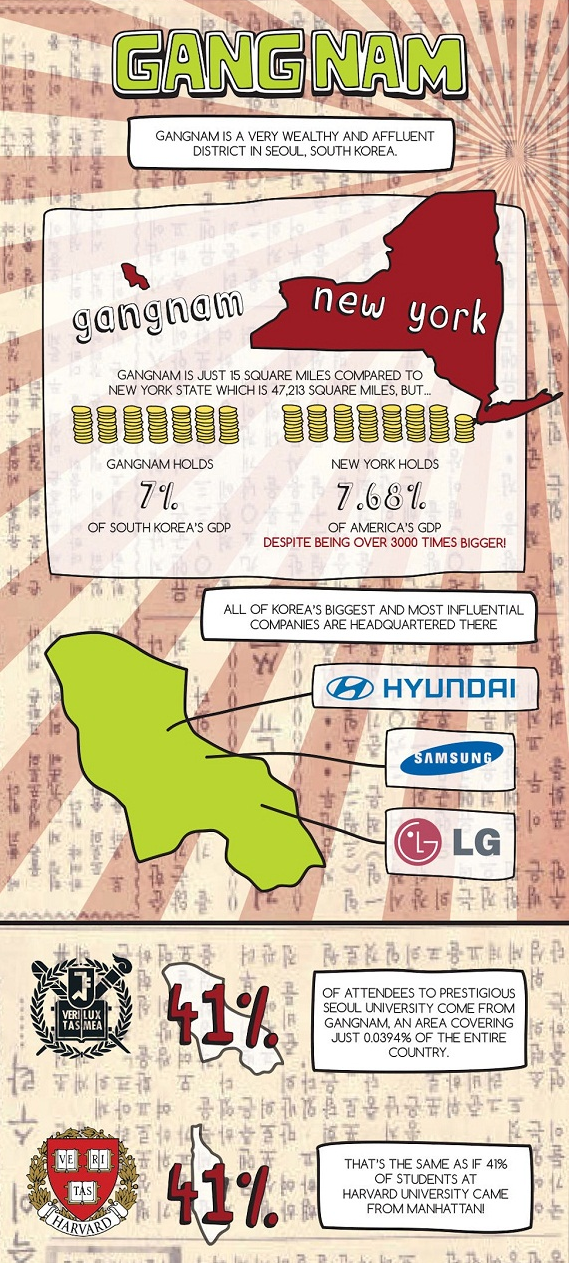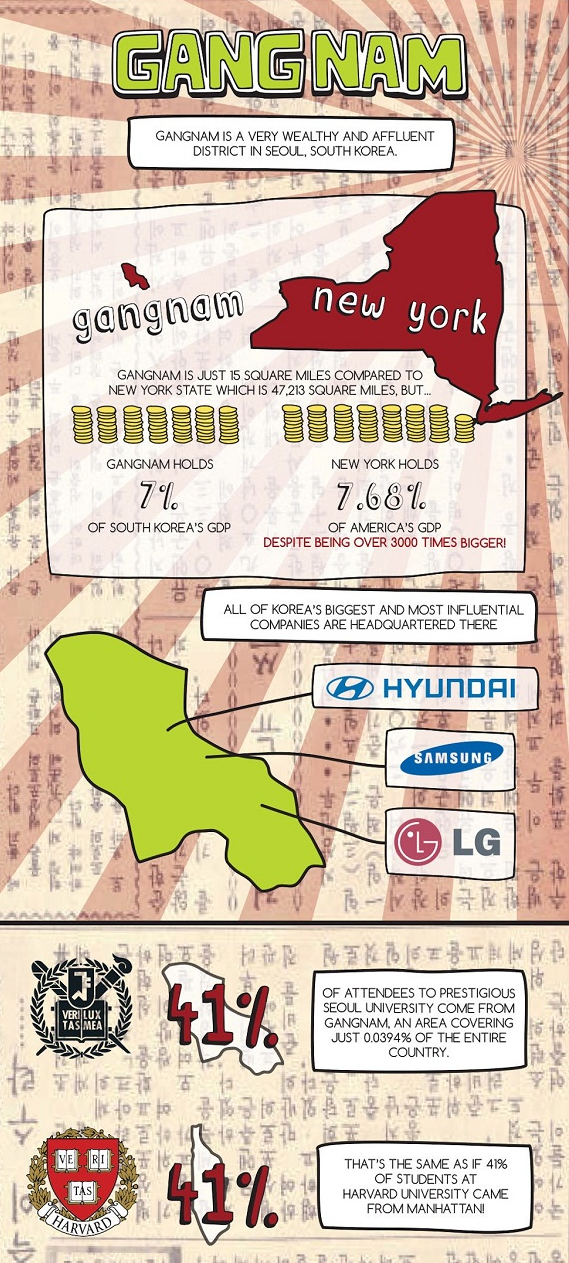The Gangnam Style! sensation is all over the internet, complete with parodies that both honor and mock the original. This first video is the original, which in a few short months received well over 200 million views on YouTube and shows no signs of slowing down. PSY is a legitimate star, appearing on the Today Show, with Ellen DeGeneres and Saturday Night Live to name a few.
This video is flashy, arrogant and decadent, but in a self-referential style. The goofiness isn’t just unintentional comedy, but part of the intended critique of the song. Still, the playful absurdity has made this a perfect target for parodies (including Saturday Night Live), and it’s infectiousness is difficult to explain or quantify still Korean rap has never had such an impact on the global scene (who ever never of ANY Korean rapper before this?). My cultural geography class has been discussing the meaning behind this.
Questions to Ponder: Considering the concept of cultural diffusion, what do we make of this phenomenon? What cultural combinations are seen in this? How has the technological innovations changed how cultures interact, spread and are replicated?
This first parody from the SNL crew highlights the inexplicable, highly-infectious nature of a viral pop culture sensation.
The University of Oregon parody put in their own impressive performance:
The Haka performed by the New Zealand rugby team (the “All Blacks”) is itself a combination of traditional and popular culture. Here in this photo mashup, it gets blended into other cultural motifs.
This next one is a dramatic departure from the other parodies, since Korean culture has received so much attention, those creating this parody have taken the opportunity to shine the spotlight on the political oppression in North Korea. Gangnam Style here is a platform for greater global awareness.
In addition to the cultural impact of this video, it is important to look at the economic context of South Koren Music industry (as this NPR podcast nicely does).
Now to the original context of the video. PSY’s continual reference to Gangnam, is important: it’s an affluent neighborhood in Seoul, South Korea. The entire video can be seen as mocking reference to the disproportionate social influence that the neighborhood has in South Korea. The infographic below notes that Gangnam a neighborhood of only 15 square miles, accounts for 7% of the NATIONAL economy. The most elite university in South Korea, Seoul University has 41% of its students coming from Gangnam. Major corporations such as Samsung, LG and Hyundai are headquartered there. An article in the Atlantic also examined the subtext within this video. Does this change geographic context change our interpretation of Gangnam Style and the intention of PSY’s work?
For additional context, here is the full infographic.







September 29, 2012 at 9:08 pm
It is amazing to me how much the Gangnam style has exploded. I’m actually in the middle of creating a project surrounding the topics of culture and globalization. I’m hoping to have my students create a version of Gangnam style unique to their location and local culture.
September 30, 2012 at 8:09 pm
Gangnam style is everywhere you look, trending topics on yahoo, on the radio and even on SNL. Without the world wide web this song wouldn’t be what it is right now. It wouldn’t even be nominated for a EMA award without the help of youtube. The song is so catchy its easy for it to be replicated to almost anything (theres even a star trek version on youtube). Rap is something PSY does well in his smash hit, being outside of the k-pop cultural norm makes this more interesting to people all over the world.
October 2, 2012 at 9:12 am
Gangnam Style is famous throughout the world and this is famous when it comes to South Korean Popular Culture. Gangnam is a real city in South Korea. It’s been all over the music industry and also it has gotten onto Facebook and Youtube as a viral video
October 16, 2012 at 6:31 am
The cultural diffusion of the phenomenon of pop, rap and hip hop music had reached rapidly the attention of youngest generation duty to technology media as the internet. Today technological innovations as cell, iPhone, iPod, table, and others had made easy and faster the interaction of new ideas, music, clothing, food and others. For example, every time the update cell comes to the market; it presents in videos and commercial in YouTube and Facebook before it is available in the market. Every teenager wants to buy the new innovation because it is wanted by others. This phenomenon had influenced the way the kids dress, dance, and how expresses themselves. They imitate each other in many ways as they please. We can see the cultural combinations of South Korea style, North America style, and Western Europe style.
October 22, 2012 at 5:56 am
As of October 22 Gangnam Style has over 527,000,000 hits on YouTube and continues to show how the Internet has changed the world and the way we learn and are exposed to new ideas, customs, and cultures.
December 23, 2012 at 9:10 am
You can certainly see your expertise in the work you write. The world hopes for more passionate writers like you who aren’t afraid to mention how they believe. All the time follow your heart.